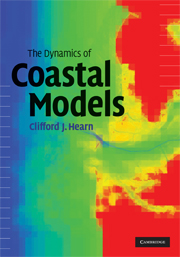Book contents
- Frontmatter
- Contents
- Preface
- Acknowledgements
- Note on mathematics and model codes
- 1 Prelude to modeling coastal basins
- 2 Currents and continuity
- 3 Box and one-dimensional models
- 4 Basic hydrodynamics
- 5 Simple hydrodynamic models
- 6 Modeling tides and long waves in coastal basins
- 7 Mixing in coastal basins
- 8 Advection of momentum
- 9 Aspects of stratification
- 10 Dynamics of partially mixed basins
- 11 Roughness in coastal basins
- 12 Wave and sediment dynamics
- References
- Index
- References
2 - Currents and continuity
Published online by Cambridge University Press: 18 December 2009
- Frontmatter
- Contents
- Preface
- Acknowledgements
- Note on mathematics and model codes
- 1 Prelude to modeling coastal basins
- 2 Currents and continuity
- 3 Box and one-dimensional models
- 4 Basic hydrodynamics
- 5 Simple hydrodynamic models
- 6 Modeling tides and long waves in coastal basins
- 7 Mixing in coastal basins
- 8 Advection of momentum
- 9 Aspects of stratification
- 10 Dynamics of partially mixed basins
- 11 Roughness in coastal basins
- 12 Wave and sediment dynamics
- References
- Index
- References
Summary
Modeling in coastal basins is based on conservation, or continuity, laws for a series of quantities that are input at boundaries and point sources into the modeled basin. These laws include the conservation of mass (or in the simplest case, volume). They provide the fundamental ingredients of all models of coastal basins. Conservation of momentum provides the dynamic, or hydrodynamic, part of a model and corresponds to the use of Newton's law of motion. Although we delay consideration of the details of these dynamics until Chapter 4, it is important to emphasize that most models contain a dynamical component (although that component may be largely implicit). In this chapter and Chapter 3, we consider continuity for a wide spectrum of substances such as heat, salt, sediments, nutrients, plankton, etc. Not all these substances are necessarily conserved in the truest sense, but we are able trace their movement between various compartments of the model. Continuity, or conservation of these quantities, with a limited hydrodynamic component does provide some very useful modeling techniques, and also lays the basis of our understanding of coastal basins.
Position of a point
Models of ocean dynamics are usually based on a set of Cartesian coordinates that are universally labeled x, y in the horizontal, called the horizontal distances, and z measured upwards in the vertical, called the height.
- Type
- Chapter
- Information
- The Dynamics of Coastal Models , pp. 32 - 66Publisher: Cambridge University PressPrint publication year: 2008

